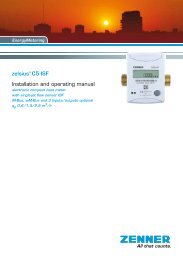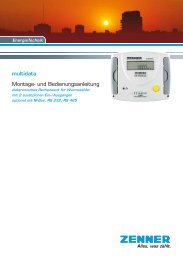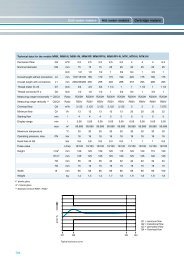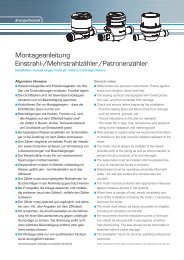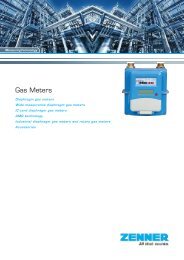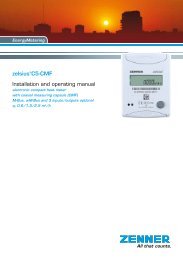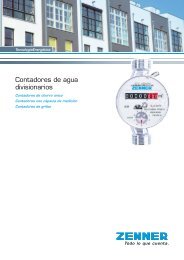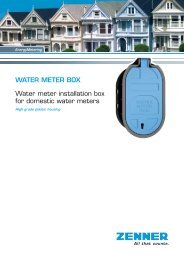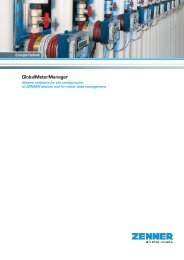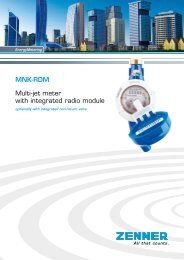zelsius® Installation and operating manual - Alphatech
zelsius® Installation and operating manual - Alphatech
zelsius® Installation and operating manual - Alphatech
You also want an ePaper? Increase the reach of your titles
YUMPU automatically turns print PDFs into web optimized ePapers that Google loves.
EnergyMetering<br />
zelsius ®<br />
<strong>Installation</strong> <strong>and</strong> <strong>operating</strong> <strong>manual</strong><br />
Electronic compact heat meter<br />
M-Bus <strong>and</strong> 2 inputs/outputs optional<br />
Coaxial measuring capsule 2"<br />
q p 0.6/1.5/2.5 m³/h<br />
All that counts
General information<br />
With zelsius ® you have acquired one of the most<br />
up-to-date, modern heat meters currently available<br />
on the market.<br />
Expressive symbols in the display <strong>and</strong> easy menu<br />
navigation make readout simple. It can be operated<br />
with one single button. The meter is equipped<br />
with a long-life battery made for operation during<br />
the initial verification validity period (5 years)<br />
including a reserve of at least another year.<br />
Electro-magnetic interference<br />
zelsius ® fulfils the national <strong>and</strong> international<br />
requirements for interference resistance. To<br />
avoid malfunctions due to other interferences,<br />
do not install fluorescent lamps, switch cabinets<br />
or electric devices such as motors or pumps in<br />
the immediate vicinity of the meter (minimum<br />
distance 1 m). Cables leaving the meter should<br />
not be laid parallel to live cables (230V, minimum<br />
distance 0.2 m).<br />
Initial verification<br />
zelsius ® is produced <strong>and</strong> tested in compliance<br />
with the new european measuring instruments directive<br />
(MID). According to this directive, devices<br />
do no longer carry an initial verification stamp, but<br />
rather the year of the device’s declaration of conformity<br />
(recognizable on the front of the device,<br />
for example: M07). The MID controls the use of<br />
heat meters up to the moment they are placed on<br />
the market resp. their first putting into use. After<br />
this, the national regulations for devices subject to<br />
legal verification apply within the EC.<br />
The duration of initial verification validity in Germany<br />
remains 5 years for heat meters. After this<br />
period has expired, the measuring device may no<br />
longer be used for billing in commercial use. The<br />
regulations resp. validity period may vary in other<br />
countries of the EC.<br />
Care instructions<br />
Clean plastic surfaces with a damp cloth only.<br />
Do not use any scouring or aggressive cleaning<br />
agents!<br />
The device is maintenance-free during the<br />
service life. Repairs can only be made by the<br />
manufacturer.<br />
Declaration of Conformity<br />
ZENNER International GmbH & Co. KG declares<br />
that this product with the number of the EC typeexamination<br />
certificate DE-07-MI004-PTB008<br />
complies with the requirements of the EC<br />
directives 2004/22/EC (Measuring instruments<br />
directive) <strong>and</strong> 89/336/ EEC (electro-magnetic<br />
compatibility).<br />
The most up-to-date information about this<br />
product can be found at www.zenner.com<br />
2
Status display / Error codes<br />
The symbols in the table below show the meter’s operational status. The status messages only appear<br />
in the main display (energy)!<br />
The temporary display of the warning triangle can be caused by special <strong>operating</strong> states <strong>and</strong> does not<br />
always mean that the device is malfunctioning. However, should the symbol be displayed over a longer<br />
period of time you should contact the service company.<br />
Symbol Status Event<br />
Flow existent -<br />
Attention!<br />
Check system / device for errors<br />
Data transmission -<br />
Emergency operation<br />
Exchange device<br />
Error codes show faults detected by zelsius ® . If more than one error appears, the sum of the error codes<br />
is displayed: Error 1005 = error 1000 <strong>and</strong> error 5.<br />
Code Error Event<br />
1 Hardware error Exchange device<br />
2 Interruption supply sensor "<br />
3 Interruption return sensor "<br />
4 Hardware error "<br />
5 Short circuit supply sensor "<br />
6 Short circuit return sensor "<br />
100 Emergency operation "<br />
1000 Battery life time exceeded "<br />
2000 Initial verification expired "<br />
8001 - 5 Memory error "<br />
3
Technical data<br />
Temperature range calculator °C 1 – 130<br />
Temperature range flow sensor °C 10 – 90<br />
Temperature difference range kelvin 3 – 100*<br />
Temperature sensor type<br />
PT500<br />
Temperature range sensor °C 0 – 105 (130)<br />
Diameter sensors mm 5.0/DS acc. to EN 1434<br />
Cable length sensor m 1.5 (optional 3/5)<br />
Nominal flow q p m³/h 0.6 1.5 2.5<br />
Maximum flow q s m³/h 1.2 3.0 5.0<br />
Minimum flow q i I/h 24 60 100<br />
Starting flow horizontal approx. I/h 4 4 6<br />
Operation pressure PS/PN, max. bar 16<br />
Pressure loss at qp bar < 0.25<br />
Display range LCD<br />
8-digit<br />
Battery V 3.0 Lithium<br />
Battery life years > 6<br />
Protection class IP 54<br />
Ambient temperature range °C 5 – 55<br />
Weight g ca. 680<br />
Mechanical/electro-magnetic class<br />
M1/E1<br />
Measurement accuracy class 3<br />
*Values for symmetrical temperature sensors installation. For other types of installation the values stated on the type plate apply.<br />
4
Pulse inputs <strong>and</strong> outputs (optional)<br />
The pulse value can be called up in the display (see the display overview, Level 1) for devices with two<br />
pulse inputs.<br />
The pulse value of the outputs is permanently set <strong>and</strong> corresponds with the last position of the<br />
associated display value.<br />
Example:<br />
Output 1 = energy output<br />
Energy display = XXXXX.XX MWh<br />
Last position = 0.01 MWh = 10 kWh<br />
Output pulse = 10 KWh<br />
Technical data I/O<br />
Load<br />
max. 30V DC/20 mA<br />
I/O 1, 2<br />
Open Drain, n-channel FET<br />
Cable<br />
D=4.9mm, 6-core<br />
Pulse-duty factor 1:1 (out); 1:5 (in)<br />
Cable length<br />
Input frequency<br />
1.5 m<br />
max. 1 Hz<br />
Input<br />
Output<br />
A firmly attached cable is included: external<br />
wiring must be done by qualified personnel.<br />
5
M-Bus (optional)<br />
The optional M-Bus interface complies with the norm EN 1434-3 <strong>and</strong> operates with 2400 baud fixed.<br />
Both of the cable cores can be connected to the M-Bus network in any order.<br />
Colour Connection Meaning<br />
yellow NC not connected<br />
pink M-Bus 1 M-Bus line 1<br />
grey M-Bus 2 M-Bus line 2<br />
green I/O 1 I/O 1<br />
white GND common ground for I/O 1 <strong>and</strong> I/O 2<br />
brown I/O 2 I/O 2<br />
ZENNER International GmbH & Co. KG<br />
Römerstadt 4<br />
D-66121 Saarbrücken<br />
Telephone +49 681 99 676-0<br />
Fax +49 681 99 676-100<br />
E-Mail info@zenner.com<br />
Internet www.zenner.com<br />
ZENNER is a registered trademark of ZENNER International GmbH & Co. KG.<br />
Subject to modifications. Any liability for misprints <strong>and</strong> errors excluded. SAP116850_080723_EN<br />
6
<strong>Installation</strong> instructions<br />
General information<br />
The installation of the measuring capsule basically<br />
takes place in a single pipe connection<br />
piece (EAS) with the connection thread G 2 B<br />
<strong>and</strong> the marking "ZENNER EN 14154 (2005)".<br />
The use of transition pieces or adapters is not<br />
permissible.<br />
ZENNER recommends to use direct temperature<br />
measurement <strong>and</strong> not to use immersion sleeves.<br />
The maximum heating water temperature at the<br />
flow sensor may not exceed 90ºC. Make sure no<br />
heating water escapes during installation – this<br />
can cause burns!<br />
The current laws <strong>and</strong> regulations have to be<br />
observed, especially EN 1434 part 1+6, (in<br />
Germany also AGFW directive FW202 <strong>and</strong><br />
DIN 4713 part 4 <strong>and</strong> the initial verification<br />
directive).<br />
At devices with M-Bus the general rules of<br />
technology <strong>and</strong> the respective regulations for<br />
electrical installations have to be followed. The<br />
installation has to be done by qualified professional<br />
personnel. Read this instructions carefully<br />
right up to the end before starting to mount<br />
the device.<br />
Notes EAS<br />
■ Mount ball valves up- <strong>and</strong> downstream of the EAS.<br />
■ Consider the correct installation point (supply or<br />
return). Normally this is the return pipe (cooler<br />
pipe at heating systems).<br />
■ Consider the correct flow direction. This is indicated<br />
by an arrow on the side of the EAS. The<br />
use of flow direction inverters is forbidden!<br />
■ Install horizontally or vertically only, not tilted,<br />
inclined or overhead. <strong>Installation</strong> into horizontal<br />
or upstreaming or downstreaming pipelines.<br />
■ Do not install at highest point of piping to avoid<br />
air inside the flow sensor.<br />
■ Consider the dimensions of the heat meter.<br />
Axis-centre distance between two EAS 135<br />
mm minimum. Keep about 1 meter distance<br />
between zelsius ® <strong>and</strong> electromagnetic sources<br />
of interference like switch cabinets, motors or<br />
pumps. Keep about 0.2 m distance to power<br />
cables. Keep min. 3 cm free mounting space<br />
around the device.<br />
Notes ball valves<br />
■ Mount ball valves up- <strong>and</strong> downstream of the<br />
EAS.<br />
■ Mount a ball valve with bore M10x1 for direct<br />
sensors in the supply. This one is used for<br />
mounting the supply sensor.<br />
7
<strong>Installation</strong> of the energy meter<br />
■ Flush the system thoroughly before installing<br />
the meter.<br />
■ Close valves <strong>and</strong> release pressure. Screw out<br />
the overflow cap (2) or the existing measuring<br />
capsule.<br />
■ Check the seal face <strong>and</strong> thread on the measuring<br />
capsule <strong>and</strong> the EAS for damage.<br />
■ Remove the old profile seal, clean the seal<br />
face <strong>and</strong> insert the new one (3) into the EAS<br />
(4) with the flat side up.<br />
■ Attention: insert only one profile seal! The<br />
O-ring on the meter’s filter must be fitted into<br />
the groove. Use only new <strong>and</strong> flawless sealing<br />
material.<br />
■ Remove the protective cap (1) from the new<br />
measuring capsule (5) <strong>and</strong> then screw into the<br />
EAS (4).<br />
■ Tighten measuring capsule up to the metallic<br />
stop with a hook wrench (for example: according<br />
to DIN 1810 A, 68-75 mm).<br />
■ Turn heat calculator to desired reading position.<br />
Installing the temperature sensors<br />
■ The installation of the temperature sensors<br />
should be preferably symmetrical <strong>and</strong> direct<br />
installation. Do not remove the return sensor if<br />
already mounted in the flow sensor.<br />
■ Sensors are colour-coded (red = supply, blue<br />
= return).<br />
■ The connecting cables may not be buckled,<br />
extended or shortened. The seal at the sen-<br />
5)<br />
1)<br />
2)<br />
3)<br />
4)<br />
sor installation point on the measuring capsule<br />
may not be damaged.<br />
■ Remove locking screw <strong>and</strong> seal at the ball<br />
valve completely, if existing.<br />
■ Attach the O-ring to the installation aid (the 2nd<br />
O-ring is only a spare O-ring). Using the installation<br />
aid, insert the O-ring into the installation<br />
point according to DIN EN 1434 with a slight<br />
circular motion.<br />
■ Using the other end of the installation aid bring<br />
the O-ring into the correct position.<br />
8
■ Insert the 2 halves of the plastic connector into<br />
the sensor’s three notches (crimps) <strong>and</strong> press<br />
them together. Use the installation aid as positioning<br />
aid. Insert the temperature sensor into<br />
the installation point <strong>and</strong> screw it in tightly until<br />
the dead stop of the seal on the 12-point is<br />
reached (mounting torque 3-5 Nm).<br />
■ Secure the sensor after installation against<br />
unauthorised removal with appropriate sealing<br />
(available as a sealing set)!<br />
Putting into use<br />
■ Open vales carefully <strong>and</strong> check installation for<br />
leakage.<br />
■ While the system is <strong>operating</strong>, check whether<br />
the volume display proceeds <strong>and</strong> the temperatures<br />
displayed correspond with the actual<br />
temperatures (see the display overview).<br />
■ Wait for the temperature display to be updated<br />
(1-2 sec).<br />
■ Secure the measuring capsule <strong>and</strong> the EAS<br />
with the enclosed sealing material against<br />
unauthorised removal.<br />
1) 2) 3) 4)<br />
<strong>Installation</strong> DF-adapter<br />
5)<br />
Sensor installation for zelsius ® with the return sensor<br />
integrated in the measuring capsule<br />
9
Dimensions<br />
Height compact version:<br />
Width heat computer:<br />
Length heat computer:<br />
H = 80 mm<br />
E = 18.5 mm<br />
72 mm<br />
100 mm<br />
Connection sizes<br />
Nominal flow qp m³/h 0.6 1.5 2.5<br />
Nominal diameter DN mm 15 15 20<br />
Overall length EAS L mm 110 110 130<br />
Thread at meter " 3/4 3/4 1<br />
10
Level 1 Level 2<br />
H<br />
H<br />
You can switch levels<br />
at any point in the menu.<br />
Energy (main display)<br />
Heat on S.R.D.<br />
Cooling (optional)<br />
Date of S.R.D.<br />
Volume<br />
S.R.D. value external meter 1<br />
L<br />
Volume external meter 1<br />
H<br />
Pulse value meter 1<br />
S.R.D. value external meter 2<br />
Monthly consumption<br />
L<br />
L<br />
L<br />
H<br />
H<br />
Volume external meter 2<br />
Pulse value meter 2<br />
Current monthly consumption<br />
Date Month 1 Energy consumption<br />
Segment test<br />
Serial number<br />
Date Month 2 Energy consumption<br />
S<br />
Supply temperature<br />
Customer number<br />
S<br />
Return temperature<br />
Temperature difference<br />
Flow rate<br />
Note<br />
Depending on your meter's model its displays can differ in number <strong>and</strong> order<br />
from those shown here.<br />
Current output<br />
S<br />
You can download a complete <strong>and</strong> detailed product description in our product<br />
area at www.zenner.com.<br />
11
Level 3<br />
Legend<br />
H<br />
Sensor type <strong>and</strong> installation point<br />
Model number<br />
S<br />
Press the button briefly (S)<br />
to switch through the display<br />
from top to bottom. When you<br />
have reached the last menu<br />
item the device automatically<br />
jumps back to the menu item<br />
at the top (loop).<br />
S<br />
1st monthly value heat energy<br />
Initial verification (validity in Germany)<br />
M-bus address<br />
Time<br />
L<br />
Press the button for about 2<br />
seconds (L), wait for the door<br />
symbol to appear (upper right<br />
corner of the display) <strong>and</strong><br />
then release the button. The<br />
menu is then updated resp.<br />
switches to the sub-menu.<br />
Date<br />
Error status<br />
H<br />
Hold down the button (H)<br />
until the device switches to<br />
another level or switches<br />
back from the sub-menu.<br />
Software version<br />
S<br />
12



